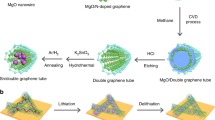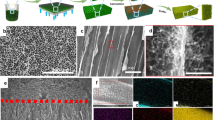Abstract
Thin (≤20 μm) and free-standing Li metal foils would enable precise prelithiation of anode materials and high-energy-density Li batteries. Existing Li metal foils are too thick (typically 50 to 750 μm) or too mechanically fragile for these applications. Here, we developed a facile and scalable process for the synthesis of an ultrathin (0.5 to 20 μm), free-standing and mechanically robust Li metal foil within a graphene oxide host. In addition to low areal capacities of ~0.1 to 3.7 mAh cm−2, this Li foil also has a much-improved mechanical strength over conventional pure Li metal foil. Our Li foil can improve the initial Coulombic efficiency of graphite (93%) and silicon (79.4%) anodes to around 100% without generating excessive Li residue, and increases the capacity of Li-ion full cells by 8%. The cycle life of Li metal full cells is prolonged by nine times using this thin Li composite anode.
This is a preview of subscription content, access via your institution
Access options
Access Nature and 54 other Nature Portfolio journals
Get Nature+, our best-value online-access subscription
$29.99 / 30 days
cancel any time
Subscribe to this journal
Receive 12 digital issues and online access to articles
$119.00 per year
only $9.92 per issue
Buy this article
- Purchase on Springer Link
- Instant access to full article PDF
Prices may be subject to local taxes which are calculated during checkout





Similar content being viewed by others
Data availability
All relevant data are included in the paper and its Supplementary Information. Source data are provided with this paper.
References
Armand, M. & Tarascon, J. M. Building better batteries. Nature 451, 652–657 (2008).
Chu, S. & Majumdar, A. Opportunities and challenges for a sustainable energy future. Nature 488, 294–303 (2012).
Lin, D., Liu, Y. & Cui, Y. Reviving the lithium metal anode for high-energy batteries. Nat. Nanotechnol. 12, 194–206 (2017).
Liu, J. et al. Pathways for practical high-energy long-cycling lithium metal batteries. Nat. Energy 4, 180–186 (2019).
Cheng, X.-B., Zhang, R., Zhao, C.-Z. & Zhang, Q. Toward safe lithium metal anode in rechargeable batteries: a review. Chem. Rev. 117, 10403–10473 (2017).
Lin, D. et al. Layered reduced graphene oxide with nanoscale interlayer gaps as a stable host for lithium metal anodes. Nat. Nanotechnol. 11, 626–632 (2016).
Tikekar, M. D., Choudhury, S., Tu, Z. & Archer, L. A. Design principles for electrolytes and interfaces for stable lithium-metal batteries. Nat. Energy 1, 16114 (2016).
Albertus, P., Babinec, S., Litzelman, S. & Newman, A. Status and challenges in enabling the lithium metal electrode for high-energy and low-cost rechargeable batteries. Nat. Energy 3, 16–21 (2018).
Chen, S. et al. Critical parameters for evaluating coin cells and pouch cells of rechargeable Li-metal batteries. Joule 3, 1094–1105 (2019).
Sun, Y. et al. High-capacity battery cathode prelithiation to offset initial lithium loss. Nat. Energy 1, 15008 (2016).
Cheng, Q. et al. Graphene-like-graphite as fast-chargeable and high-capacity anode materials for lithium ion batteries. Sci. Rep. 7, 14782 (2017).
Weber, R. et al. Long cycle life and dendrite-free lithium morphology in anode-free lithium pouch cells enabled by a dual-salt liquid electrolyte. Nat. Energy 4, 683–689 (2019).
Xiao, J. et al. Understanding and applying coulombic efficiency in lithium metal batteries. Nat. Energy 5, 561–568 (2020).
Yu, Z. et al. Molecular design for electrolyte solvents enabling energy-dense and long-cycling lithium metal batteries. Nat. Energy 5, 526–533 (2020).
Schmuch, R., Wagner, R., Hörpel, G., Placke, T. & Winter, M. Performance and cost of materials for lithium-based rechargeable automotive batteries. Nat. Energy 3, 267–278 (2018).
Shi, P. et al. Electrochemical diagram of an ultrathin lithium metal anode in pouch cells. Adv. Mater. 31, 1902785 (2019).
Mashtalir, O., Nguyen, M., Bodoin, E., Swonger, L. & O’Brien, S. P. High-purity lithium metal films from aqueous mineral solutions. ACS Omega 3, 181–187 (2018).
Kato, A., Hayashi, A. & Tatsumisago, M. Enhancing utilization of lithium metal electrodes in all-solid-state batteries by interface modification with gold thin films. J. Power Sources 309, 27–32 (2016).
Chen, H. et al. Electrode design with integration of high tortuosity and sulfur-philicity for high-performance lithium-sulfur battery. Matter 2, 1605–1620 (2020).
Liu, Y. et al. Lithium-coated polymeric matrix as a minimum volume-change and dendrite-free lithium metal anode. Nat. Commun. 7, 10992 (2016).
Liang, Z. et al. Composite lithium metal anode by melt infusion of lithium into a 3D conducting scaffold with lithiophilic coating. Proc. Natl Acad. Sci. USA 113, 2862–2867 (2016).
Chi, S.-S., Liu, Y., Song, W.-L., Fan, L.-Z. & Zhang, Q. Prestoring lithium into stable 3D nickel foam host as dendrite-free lithium metal anode. Adv. Funct. Mater. 27, 1700348 (2017).
Huang, G. et al. Lithiophilic 3D nanoporous nitrogen-doped graphene for dendrite-free and ultrahigh-rate lithium-metal anodes. Adv. Mater. 31, 1805334 (2019).
Wang, Y. & Cheng, Y.-T. A nanoindentation study of the viscoplastic behavior of pure lithium. Scr. Mater. 130, 191–195 (2017).
Tariq, S. et al. Li material testing - Fermilab Antiproton Source lithium collection lens. In Proceedings of the 2003 Particle Accelerator Conference 1452–1454 (IEEE Xplore, 2003).
de Vasconcelos, L. S., Xu, R. & Zhao, K. Operando nanoindentation: a new platform to measure the mechanical properties of electrodes during electrochemical reactions. J. Electrochem. Soc. 164, A3840–A3847 (2017).
Holtstiege, F., Bärmann, P., Nölle, R., Winter, M. & Placke, T. Pre-lithiation strategies for rechargeable energy storage technologies: concepts, promises and challenges. Batteries 4, 4 (2018).
Ren, J. J. et al. Pre-lithiated graphene nanosheets as negative electrode materials for Li-ion capacitors with high power and energy density. J. Power Sources 264, 108–113 (2014).
Jang, J. et al. Chemically prelithiated graphene for anodes of Li-ion batteries. Energy Fuels 34, 13048–13055 (2020).
Yao, C. et al. An efficient prelithiation of graphene oxide nanoribbons wrapping silicon nanoparticles for stable Li+ storage. Carbon 168, 392–403 (2020).
Tomaszewska, A. et al. Lithium-ion battery fast charging: a review. eTransportation 1, 100011 (2019).
Wu, H. & Cui, Y. Designing nanostructured Si anodes for high energy lithium ion batteries. Nano Today 7, 414–429 (2012).
Sun, Y., Liu, N. & Cui, Y. Promises and challenges of nanomaterials for lithium-based rechargeable batteries. Nat. Energy 1, 16071 (2016).
Niu, C. et al. High-energy lithium metal pouch cells with limited anode swelling and long stable cycles. Nat. Energy 4, 551–559 (2019).
Zhang, Y.-j et al. Integrated reduced graphene oxide multilayer/Li composite anode for rechargeable lithium metal batteries. RSC Adv. 6, 11657–11664 (2016).
Moorthy, B. et al. Ice-templated free-standing reduced graphene oxide for dendrite-free lithium metal batteries. ACS Appl. Energy Mater. 3, 11053–11060 (2020).
Shi, F. et al. Lithium metal stripping beneath the solid electrolyte interphase. Proc. Natl Acad. Sci. USA 115, 8529–8534 (2018).
LePage, W. S. et al. Lithium mechanics: roles of strain rate and temperature and implications for lithium metal batteries. J. Electrochem. Soc. 166, A89–A97 (2019).
Acknowledgements
Part of this work was performed at the Stanford Nano Shared Facilities and Stanford Nanofabrication Facility, supported by the National Science Foundation under award ECCS-2026822. Fabrication of the ultrathin Li metal foils and the Li-metal-anode-based full cell applications are funded by Murata Manufacturing. Utilizing the ultrathin Li metal foils to prelithiate the graphite and silicon anode was supported by the Assistant Secretary for Energy Efficiency and Renewable Energy, Office of Vehicle Technologies of the US Department of Energy under the Battery Materials Research programme. Y.C. acknowledges the 20-μm-thick pure Li metal foils provided from Hydro-Québec company.
Author information
Authors and Affiliations
Contributions
Y.C. conceived the idea for the project. H.C., Y.Y., Hansen Wang and H.G. designed the experiments and fabricated the electrodes. H.C. conducted the SEM and XPS characterizations. Hongxia Wang conducted the X-ray diffraction characterization and gas chromatograph measurements. Y.K.J. fabricated the nano-Si electrodes. R.X. and L.S.V. conducted the nanoindentation characterizations. Z.H. and Y.Y. conducted the tensile strength characterizations. Y.Y. and J.W. designed the prelithiation process. H.C. and W.H. fabricated the pouch cells. W.H. collected the video for the USER reaction. H.C. and Y.Y. designed and conducted the electrochemical measurements. H.C., Y.Y., D.T.B., R.X., R.M., K.M., Y.N. and Y.C. wrote and revised the manuscript. All authors discussed the results and commented on the manuscript at all stages.
Corresponding author
Ethics declarations
Competing interests
The authors declare no competing interests.
Additional information
Peer review information Nature Energy thanks Boštjan Genorio, Tianyou Zhai and the other, anonymous, reviewer(s) for their contribution to the peer review of this work.
Publisher’s note Springer Nature remains neutral with regard to jurisdictional claims in published maps and institutional affiliations.
Supplementary information
Supplementary Information
Supplementary Figs. 1–18, Table 1, Note 1 and refs. 1–3.
Supplementary Video 1
Flexibility test of ultrathin GO film.
Supplementary Video 2
USER reaction on GO film.
Supplementary Video 3
Controllable calendaring on porous eGF film.
Supplementary Video 4
Edge-contact molten Li infusion into eGF host.
Supplementary Video 5
Flexibility test of ultrathin Li@eGF foil.
Source data
Source Data Fig. 2
Statistical source data.
Source Data Fig. 3
Statistical source data.
Rights and permissions
About this article
Cite this article
Chen, H., Yang, Y., Boyle, D.T. et al. Free-standing ultrathin lithium metal–graphene oxide host foils with controllable thickness for lithium batteries. Nat Energy 6, 790–798 (2021). https://doi.org/10.1038/s41560-021-00833-6
Received:
Accepted:
Published:
Issue Date:
DOI: https://doi.org/10.1038/s41560-021-00833-6
This article is cited by
-
Controlled large-area lithium deposition to reduce swelling of high-energy lithium metal pouch cells in liquid electrolytes
Nature Energy (2024)
-
Hierarchical Li electrochemistry using alloy-type anode for high-energy-density Li metal batteries
Nature Communications (2024)
-
A Li3P nanoparticle dispersion strengthened ultrathin Li metal electrode for high energy density rechargeable batteries
Nano Research (2024)
-
Monothetic and conductive network and mechanical stress releasing layer on micron-silicon anode enabling high-energy solid-state battery
Rare Metals (2024)
-
Amorphous Sb/C composite with isotropic expansion property as an ultra-stable and high-rate anode for lithium-ion batteries
Rare Metals (2024)



